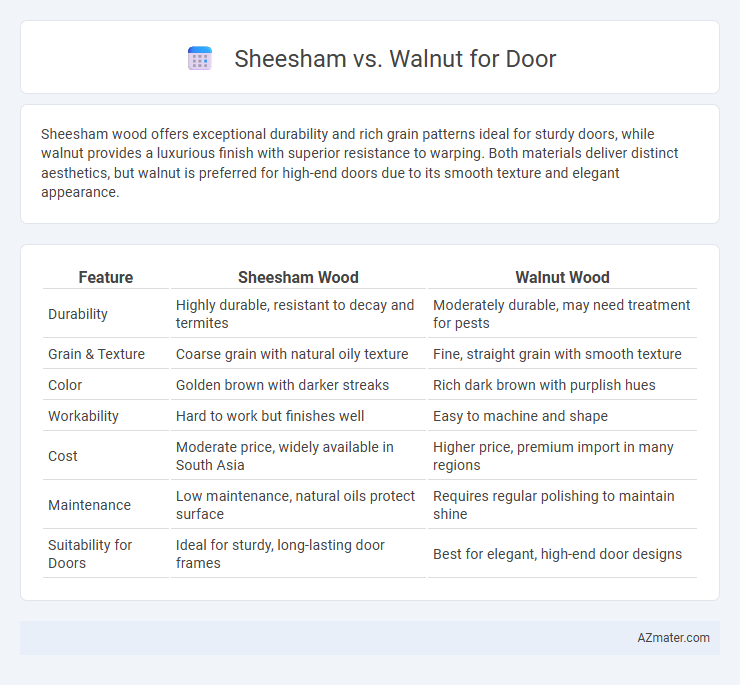Sheesham wood offers exceptional durability and rich grain patterns ideal for sturdy doors, while walnut provides a luxurious finish with superior resistance to warping. Both materials deliver distinct aesthetics, but walnut is preferred for high-end doors due to its smooth texture and elegant appearance.
Table of Comparison
| Feature | Sheesham Wood | Walnut Wood |
|---|---|---|
| Durability | Highly durable, resistant to decay and termites | Moderately durable, may need treatment for pests |
| Grain & Texture | Coarse grain with natural oily texture | Fine, straight grain with smooth texture |
| Color | Golden brown with darker streaks | Rich dark brown with purplish hues |
| Workability | Hard to work but finishes well | Easy to machine and shape |
| Cost | Moderate price, widely available in South Asia | Higher price, premium import in many regions |
| Maintenance | Low maintenance, natural oils protect surface | Requires regular polishing to maintain shine |
| Suitability for Doors | Ideal for sturdy, long-lasting door frames | Best for elegant, high-end door designs |
Introduction to Sheesham and Walnut Wood
Sheesham wood, also known as Indian rosewood, is a durable hardwood prized for its rich grain texture and natural resistance to decay, making it ideal for door construction. Walnut wood, valued for its deep, luxurious brown tones and fine grain, offers excellent strength and stability, often used in high-end furniture and architectural joinery. Both woods provide exceptional durability and aesthetic appeal, but Sheesham is preferred for its cost-effectiveness and easier availability in South Asia, while Walnut commands a premium for its superior finish and elegance.
Appearance and Grain Patterns
Sheesham wood features a rich golden to dark brown color with distinctive purple streaks, showcasing a natural luster that enhances door aesthetics. Walnut exhibits a deeper chocolate to espresso hue with a fine, straight grain and occasional curls, providing an elegant and sophisticated look. The contrasting grain patterns make Sheesham ideal for rustic or traditional doors, while Walnut suits contemporary designs requiring smooth and uniform textures.
Durability and Strength Comparison
Sheesham wood, known for its dense grain and natural oils, offers excellent durability and resistance to decay, making it a strong choice for doors in humid environments. Walnut, prized for its fine grain and high density, provides superior strength and long-lasting performance but may require more maintenance to prevent weathering. Comparing the two, Sheesham excels in moisture resistance, while walnut delivers greater hardness and impact resistance, influencing door longevity based on specific environmental conditions.
Resistance to Termites and Decay
Sheesham wood exhibits natural oils that provide strong resistance to termites and decay, making it a durable choice for doors in humid and pest-prone environments. Walnut, while aesthetically appealing with its rich grain, is comparatively less resistant to termite attacks and requires proper treatment for long-term use. For enhanced longevity in door applications, Sheesham generally outperforms Walnut in terms of natural durability against wood-boring insects and fungal decay.
Maintenance and Longevity
Sheesham wood, known for its natural oils and dense grain, offers excellent resistance to termites and requires minimal maintenance, making it highly durable for door applications. Walnut wood, prized for its rich color and smooth texture, demands more frequent sealing and polishing to prevent moisture damage but provides a long-lasting finish if properly cared for. Both woods ensure longevity, yet Sheesham's inherent oiliness gives it an edge in maintenance ease for doors exposed to varying environmental conditions.
Cost and Availability
Sheesham wood is generally more affordable and widely available in regions such as India and Southeast Asia, making it a cost-effective option for doors. Walnut, on the other hand, tends to be more expensive due to its limited availability and higher demand in North America and Europe. The price difference is influenced by walnut's premium aesthetics and durability, while Sheesham offers good strength at a lower cost.
Suitability for Door Designs
Sheesham wood offers high durability and rich grain patterns, making it ideal for traditional and rustic door designs that require strength and aesthetic warmth. Walnut wood, known for its smooth texture and dark, elegant finish, suits contemporary and luxury door designs where refinement and subtle sophistication are desired. Both woods provide excellent stability and resistance to warping, but Sheesham is better suited for intricate carvings, while Walnut excels in sleek, minimalist styles.
Finishing and Customization Options
Sheesham wood offers a rich, natural grain with warm hues that respond well to a variety of finishing techniques, including staining and polishing, enhancing its rustic appearance for doors. Walnut provides a smooth, fine texture with a deep, chocolate-brown color that takes well to precise finishing methods such as hand-rubbed oils or lacquer, delivering a sleek and sophisticated door look. Customization options for Sheesham doors include intricate carving and varied stain colors, while Walnut doors often feature elegant inlays and uniform finishes suited for modern and classic designs.
Environmental Impact and Sustainability
Sheesham wood, sourced from Dalbergia trees native to India, is considered sustainable when harvested from well-managed plantations, as these trees regenerate relatively quickly and support local ecosystems. Walnut wood, primarily from Juglans species found in North America and Europe, tends to have a higher environmental impact due to slower growth rates and less sustainable forestry practices in some regions. Choosing Sheesham over Walnut for doors often results in lower carbon footprints and better support for sustainable forestry initiatives.
Final Verdict: Which Wood is Best for Doors?
Sheesham offers excellent durability and rich grain patterns ideal for traditional doors, while Walnut provides superior strength, smooth texture, and a luxurious finish suited for modern aesthetics. Walnut's resistance to warping and its fine polish make it the preferred choice for high-end, long-lasting doors, outperforming Sheesham in overall refinement and stability. For the best door wood, Walnut is the top recommendation due to its combination of strength, appearance, and lasting quality.

Infographic: Sheesham vs Walnut for Door
 azmater.com
azmater.com